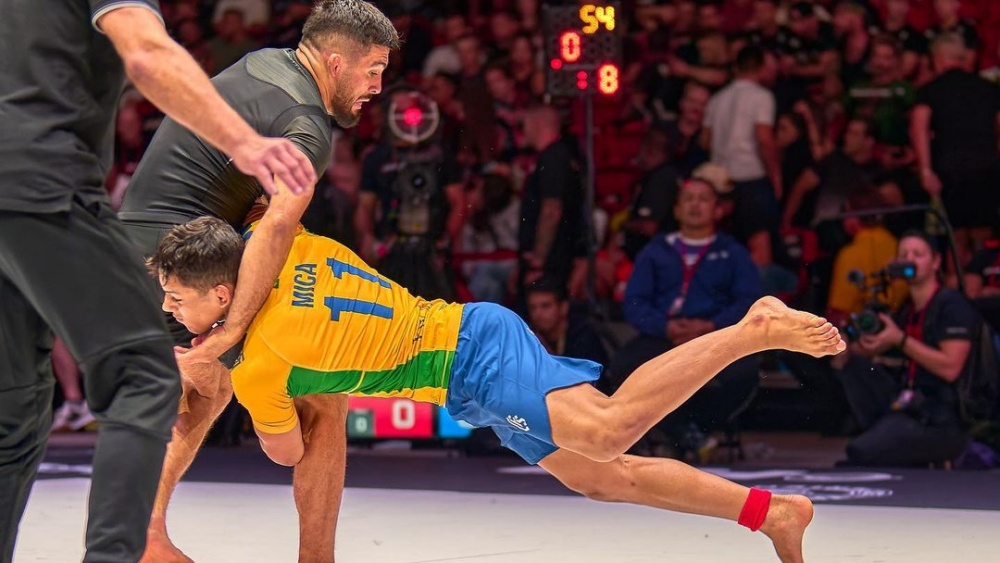Guest post by Evolve MMA, Asia’s premier championship brand for martial arts. It has the most number of World Champions on the planet. Named as the #1 ranked martial arts organization in Asia by CNN, Yahoo! Sports, FOX Sports, Evolve MMA is the top rated BJJ gym in Singapore.
All matches start from the standup. This makes takedowns an integral part of BJJ, especially in No-Gi grappling. Learning takedowns takes time and requires a lot of drilling. Though it is not necessary to master all takedowns, it is important to master a couple of takedown techniques that fit your game. Even more so, exposure to different takedowns gives you the knowledge to counter them, making you a tougher grappler to deal with. This article will give you five ways to counter takedowns in No-Gi Jiu-Jitsu.
1) Underhook
The underhook is a fundamental move and is the most used clinching hold to prevent opponents from going further in their takedown entries. An underhook is usually applied by placing your arms underneath the opponent’s arm to get the inside position. Doing this will help you control their shoulders and upper body. A single underhook is done with one arm while your other hand holds the opponent’s wrist or applies an overhook, whereas a double underhook is applied with both arms, which can lead to moves like the body lock.
Pummeling is a drill you can perform with a training partner to work on your ability to swim for the underhook during a match. If you are new to this drill, aim for the chest-to-chest bump between the transition of the underhooks. To add more challenge, you can add resistance as you get used to pummeling by keeping the connection tight and not allowing your training partner easy access to the underhook.
2) Sprawling
Along with the underhook, sprawling is a fundamental way to stuff takedowns. In grappling, the first line of defense is the head because it aligns with the body positioning as, where the head goes, the body follows. Second is the arms, as they can be used to post against the opponent. Next is the sprawl, which is used as the primary defense against a takedown shot when the opponent manages to get to your legs.
Sprawling is done by immediately bringing your lead leg back while using your hip to crush the opponent’s shoulder or head. Remember to not just sprawl flat on the mat but have your lower body twisting to produce the torquing motion while your upper body is squared. As you sprawl, it is crucial to understand how to come back up, as it will put you in a great position to do a counterattack. Coming back up from a sprawl is almost like the high lunge, while your rear leg circles back up to get into the fighting stance.
As often misinterpreted in grappling, sprawling is not passive but active, because the opponent is out of position right after a shot. Having a good sprawl allows you to maintain a solid position which you can use to get out of any bad spot. The element of using heavy hips is critical with the sprawl. Think of the sprawl as a drop and not a floating movement.
As good as being able to stop the opponent’s takedown attempt, the sprawl is not a stable position, which is why you should practice your timing and sprawling technique, followed by your next attacking options.
3) Front Headlock To Choke
After successfully stuffing the opponent’s takedown with a sprawl, applying the front headlock is one of the most viable options from this position. Front headlocks can be used to get behind the opponent or apply different frontal chokes such as the Anaconda, Guillotine, D’Arce, and Necktie chokes.
Upon sprawling, a front headlock can be done by grabbing your opponent’s chin with one hand while dropping your weight behind their neck. The other hand is used to grab and pull their elbow. The goal with the front headlock is to keep the opponent’s elbow away from their body while resting your weight on their neck. From there, you can begin attacking with different chokes. The guillotine is the most utilized choke in the front headlock; it is a good option, especially when facing wrestlers.
4) Throws
Throws are an excellent way to counter takedowns, especially against the single leg. The underhook allows you to set up throws because getting inside the position is a key ingredient to throwing an opponent. If you want to add throws to your game, your underhook technique should also be on point. Watch the above demonstration of how you can incorporate the throw with the underhook.
Another throw you can use if the opponent shoots for a takedown and you manage to grab a guillotine grip is the sumi gaeshi. The sumi gaeshi is an excellent tool for redirecting momentum from a takedown to throwing the opponent overhead. Remember that the sumi gaeshi is a sacrifice throw; an unsuccessful attempt may result in either a pin or a scramble.
Just like with takedowns, perform the sumi gaeshi without hesitation for better chances of success. Sacrifice throws come with risks but are highly rewarding, especially if you catch the opponent off-guard. First, develop a solid takedown defense before exploring different sacrifice throw variations.
5) Work On Takedown Defense
The most common reason why BJJ practitioners get taken down easily is that many don’t practice their standing techniques. One big reason for this is the ruleset. Many Jiu-Jitsu practitioners are content with playing guard and have no interest in the standup game. This approach may sometimes work, but it is always a smart idea to be proficient in all positions.
While learning how to defend takedowns may be challenging for most people, it is an absolutely critical skill to learn. From sports BJJ, submission grappling, MMA, and even self-defense situations, you’ll certainly get a lot of mileage from learning proper takedown defense.
Conclusion
The standup is a super important part of grappling, regardless of the ruleset. It would be best to practice grappling on your feet, as it increases your ability to use and defend/counter takedowns. Learning how to counter takedowns will surely make you a better overall grappler as you go up in rank. Please study these techniques and let us know if they work for you.


















